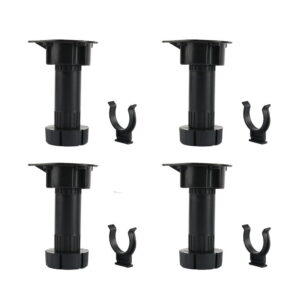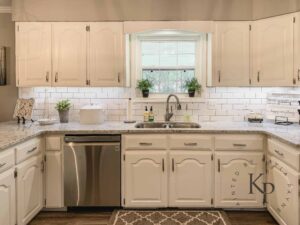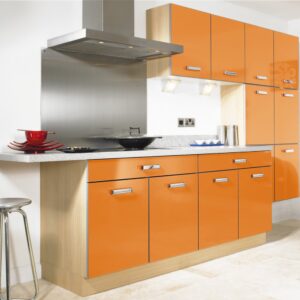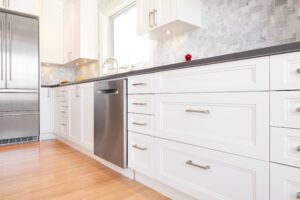When it comes to maximizing storage space in your kitchen, it’s essential to utilize every inch available. If you find yourself running out of storage options, one creative solution is to add cabinets above your existing ones. This not only provides additional storage but also enhances the aesthetic appeal of your kitchen. In this article, we will explore the benefits, considerations, and steps involved in adding kitchen cabinets above existing cabinets.
The Benefits of Adding Kitchen Cabinets Above Existing Cabinets
1. Increased Storage Space: One of the primary advantages of adding cabinets above your existing ones is the additional storage space it provides. This can be particularly beneficial if you have a small kitchen or limited cabinet space.
2. Enhanced Kitchen Design: By adding cabinets above your existing ones, you can create a seamless and cohesive look in your kitchen. This not only improves the overall design but also adds value to your home.
3. Customization Options: Adding cabinets above existing ones allows you to customize your kitchen storage to suit your specific needs. You can choose the size, style, and materials that complement your existing cabinets and overall kitchen design.
Considerations Before Adding Cabinets Above Existing Cabinets
While adding cabinets above existing ones can be a fantastic solution for additional storage, there are a few considerations to keep in mind:
1. Ceiling Height:
Before adding cabinets above your existing ones, it’s crucial to measure the height of your kitchen ceiling. Ensure that you have enough clearance space between the top of the existing cabinets and the ceiling to accommodate the new cabinets.
2. Weight Limit:
Existing cabinets are designed to support a certain amount of weight. It’s important to consult with a professional or review the manufacturer’s guidelines to ensure that adding cabinets above won’t exceed the weight limit of your existing cabinets.
3. Structural Integrity:
Before proceeding with adding cabinets above existing ones, it’s crucial to assess the structural integrity of your kitchen walls. Ensure that they can support the additional weight of the new cabinets. If there are any concerns, it’s best to consult a professional.
4. Accessibility:
Consider the accessibility of the cabinets you plan to add above your existing ones. Will they be easy to reach, or will you need a step stool or ladder? It’s essential to consider the practicality of accessing the items stored in these cabinets.
Steps to Add Cabinets Above Existing Cabinets
Adding cabinets above existing ones may seem like a complex task, but with careful planning and execution, it can be a rewarding DIY project. Here are the steps involved:
1. Measure and Plan:
Start by measuring the space above your existing cabinets. Take precise measurements of the width, height, and depth to ensure the new cabinets fit seamlessly. Consider the style and design of your existing cabinets to choose complementary ones for the added storage space.
2. Remove Existing Items:
Before installing the new cabinets, remove any items or decorations from your existing cabinets to ensure they are empty and easy to work with.
3. Remove Existing Cabinets:
Carefully remove the existing cabinets by unscrewing them from the wall. Take your time to avoid damaging the walls or the cabinets themselves. It may be helpful to have a friend assist you during this step.
4. Install Support Brackets:
To ensure the stability and support of the new cabinets, install support brackets along the back wall. These brackets will help distribute the weight evenly and prevent any sagging or damage.
5. Mount New Cabinets:
With the support brackets in place, mount the new cabinets onto the wall. Double-check their alignment and levelness to ensure a professional-looking finish. Use screws and appropriate hardware to secure the cabinets firmly.
6. Connect Cabinets:
If you are adding multiple cabinets, connect them together using cabinet connectors. These connectors will ensure that the cabinets are aligned and stable.
7. Add Doors and Hardware:
Finish off the installation by adding doors and hardware to the new cabinets. Choose handles or knobs that match your existing cabinets for a cohesive look.
8. Paint or Stain:
If desired, paint or stain the new cabinets to match the existing ones. This step will help create a seamless and integrated appearance.
Examples of Successful Kitchen Cabinet Additions
Let’s take a look at a couple of case studies showcasing successful kitchen cabinet additions:
Case Study 1: The Smith Family
The Smith family had a small kitchen with limited cabinet space. They decided to add cabinets above their existing ones to maximize storage. By carefully measuring and planning, they were able to seamlessly incorporate new cabinets that perfectly matched the existing ones. The added storage space allowed them to organize their kitchen more efficiently and declutter their countertops. The Smiths were thrilled with the transformation and the enhanced aesthetic appeal of their kitchen.
Case Study 2: The Johnsons’ Modern Kitchen
The Johnsons had a modern kitchen with sleek white cabinets. They wanted to add additional cabinets above their existing ones to maintain the minimalist design while gaining extra storage. They chose cabinets with glass doors to create an open and airy feel. The new cabinets not only provided much-needed storage space but also became a focal point, displaying their beautiful collection of dishes and glassware. The Johnsons’ kitchen went from functional to stylish, thanks to the addition of cabinets above their existing ones.
Frequently Asked Questions
1. Can I add cabinets above existing cabinets without professional help?
While adding cabinets above existing ones can be a DIY project, it’s recommended to consult with a professional, especially if you have concerns about the structural integrity or weight limit of your existing cabinets.
2. How much does it cost to add cabinets above existing cabinets?
The cost of adding cabinets above existing ones can vary depending on factors such as the size and style of the cabinets, materials used, and any additional modifications required. It’s best to obtain quotes from professionals or research the cost of materials for a more accurate estimate.
3. Can I add cabinets above cabinets with crown molding?
Yes, it is possible to add cabinets above cabinets with crown molding. However, it may require additional planning and adjustments to ensure a seamless transition between the two sets of cabinets.
4. How do I ensure the new cabinets match my existing ones?
To ensure the new cabinets match your existing ones, take precise measurements and consider factors such as style, color, and materials. It may be helpful to consult with a professional or bring samples of your existing cabinets when shopping for the new ones.
5. Are there any alternatives to adding cabinets above existing ones for additional storage?
Yes, there are alternative options for additional storage in your kitchen. These include installing open shelves, utilizing wall-mounted racks or hooks, or incorporating freestanding storage units. Consider your kitchen layout and design preferences when exploring these alternatives.
Conclusion
Adding cabinets above existing ones can be an excellent solution for maximizing storage space and enhancing the design of your kitchen. By carefully considering the benefits, planning, and following the necessary steps, you can successfully incorporate additional cabinets that seamlessly blend with your existing ones. Remember to assess the structural integrity, weight limits, and accessibility before embarking on this project. With the right approach, your kitchen will not only be more functional but also visually impressive.
Frequently Asked Questions
1. Can I add cabinets above existing cabinets without professional help?
While adding cabinets above existing ones can be a DIY project, it’s recommended to consult with a professional, especially if you have concerns about the structural integrity or weight limit of your existing cabinets.
2. How much does it cost to add cabinets above existing cabinets?
The cost of adding cabinets above existing ones can vary depending on factors such as the size and style of the cabinets, materials used, and any additional modifications required. It’s best to obtain quotes from professionals or research the cost of materials for a more accurate estimate.
3. Can I add cabinets above cabinets with crown molding?
Yes, it is possible to add cabinets above cabinets with crown molding. However, it may require additional planning and adjustments to ensure a seamless transition between the two sets of cabinets.
4. How do I ensure the new cabinets match my existing ones?
To ensure the new cabinets match your existing ones, take precise measurements and consider factors such as style, color, and materials. It may be helpful to consult with a professional or bring samples of your existing cabinets when shopping for the new ones.
5. Are there any alternatives to adding cabinets above existing ones for additional storage?
Yes, there are alternative options for additional storage in your kitchen. These include installing open shelves, utilizing wall-mounted racks or hooks, or incorporating freestanding storage units. Consider your kitchen layout and design preferences when exploring these alternatives.
Summary
Adding cabinets above existing cabinets is a practical andstylish solution for maximizing storage space in your kitchen. By carefully measuring and planning, you can seamlessly incorporate new cabinets that complement your existing ones. This not only provides additional storage but also enhances the overall design of your kitchen. However, there are a few considerations to keep in mind, such as ceiling height, weight limits, structural integrity, and accessibility.
Before embarking on this project, it’s crucial to measure the height of your kitchen ceiling to ensure there is enough clearance space for the new cabinets. Additionally, you should consult the manufacturer’s guidelines or seek professional advice to ensure that adding cabinets above won’t exceed the weight limit of your existing cabinets. Assessing the structural integrity of your kitchen walls is also important to ensure they can support the weight of the new cabinets.
Considering the accessibility of the cabinets is another important factor. Think about whether you will easily be able to reach the items stored in the cabinets or if you will need a step stool or ladder. It’s essential to prioritize practicality and convenience when designing your kitchen storage.
Once you have taken these considerations into account, you can proceed with adding cabinets above your existing ones. The process involves careful planning, removal of existing items, removal of existing cabinets, installation of support brackets, mounting the new cabinets, connecting them together, adding doors and hardware, and optionally painting or staining the cabinets to match your existing ones.
Successful case studies demonstrate the effectiveness of adding cabinets above existing ones. For example, the Smith family transformed their small kitchen by adding cabinets above their existing ones, allowing them to declutter their countertops and organize their kitchen more efficiently. The Johnsons achieved a modern and stylish look by choosing cabinets with glass doors to display their collection of dishes and glassware.
In conclusion, adding cabinets above existing cabinets is a practical and aesthetically pleasing solution for increasing storage space in your kitchen. It requires careful planning, measuring, and consideration of factors such as ceiling height, weight limits, structural integrity, and accessibility. By following the necessary steps and taking inspiration from successful case studies, you can successfully incorporate additional cabinets that enhance both the functionality and design of your kitchen. Remember to consult with professionals when needed and explore alternative storage options if adding cabinets above is not feasible for your kitchen.





